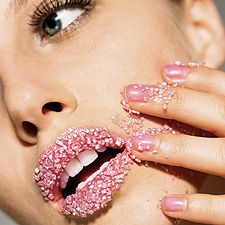Let’s delve into ways to combat glycation – besides obviously keeping sugar intake and dietary AGEs low. Since AGEing of the skin is ratcheted up in the presence of high states of oxidative stress in the skin, antioxidants play a role in the prevention of skin AGEing. The good news is that scientists have been examining ways to prevent glycation with increased intensity and have uncovered some simple nutrient-based interventions to put the brakes on the process.
While agents that actually break up AGEs and undo the disastrous damage of cross-links remain the Rosetta stone of skin-aging research, AGE formation can be inhibited and prevented. Many of the dietary items have also been shown to possess AGE-inhibiting properties. For example: – Star culinary herb turmeric, or more specifically its curcumin, has been shown to reduce glycation and cross-linking of dermal collagen in diabetic animals.
– French researchers have shown that blueberry extract can reduce AGE products in the dermis and turn off MMP enzymes that would otherwise destroy collagen.
– Canadian researchers have shown that antioxidant chemicals within the blueberry plant, even in the leaves and stems, have anti-AGE activity.
– A team from India reported that oral green tea can reduce AGE formation and prevent collagen cross-linking in animals with consistently high blood sugar.
– Japanese researchers have shown that lycopene-rich tomato paste can prevent AGE formation.
Here are some other natural agents with AGE-inhibiting properties:
 Cinnamon
Cinnamon
An ideal candidate for AGE inhibition would be one with strong antioxidant activity and the ability to balance blood sugar. Cinnamon pocesses both of these fine qualities. Oral cinnamon extract enhances the repair and regeneration of damaged collagen. One of the naturally occurring chemicals in cinnamon has recently been identified as an active factor in the regulation of blood sugar. In fact, 1 to 3 grams of cinnamon extract is helpful in blood-sugar regulation among adults with type 2 diabetes.
Like many culinary spices, cinnamon is loaded with antioxidants, and a number of these chemicals are AGE-inhibitors. The Atkins diet may be able to generate a glycation product known to cross-link collagen, but cinnamon can trap this fat cat of glycation and inactivate it. You can think of cinnamon as a true bodyguard, taking the bullet for you as the glycation molecule forms an adduct (union) with cinnamon before it can turn into a full-blown AGE and destroy your collagen. The interesting part is that the AGE-inhibiting properties of cinnamon are not solely attributed to the antioxidant activity. The structural ability of cinnamon chemicals to bind with glycation chemicals makes the difference.
Researchers from the University of Georgia reported in 2008 that among two dozen herbs and spices, cinnamon, cloves, oregano, and allspice have potent glycation-inhibiting properties and are capable of protecting our proteins from fructose-induced AGE formation.
Ginger
Another antioxidant-rich culinary spice, ginger is near the top of the AGE-inhibiting list. According to a report in the British Journal of Nutrition (2008), ginger reduced sugar-protein AGE formation by an incredible 93 percent under experimental conditions. Under these testing conditions, cinnamon was still a very close second at 88 percent inhibition of AGE formation, followed by cumin, green tea, black pepper, and basil.
Garlic
Best known as a heart-healthy herb, garlic has a long history of use in treating the diseases associated with human aging. Garlic has long been noted to contain important antioxidant phytochemicals. The latest study, published in the European Journal of Pharmacology (2007), shows that aged garlic extract can, much like cinnamon, throw its body onto the live grenade of AGE-promoting chemicals. Specifically, Japanese Kyolic aged garlic extract was shown to prevent protein fragmentation and AGE cross-linking. This AGE-inhibition is thought to be due to the high concentration of the natural chemical S-allyl cysteine in garlic. Note that aged garlic extract has fifty times more S-allyl cysteine than raw garlic. Aged garlic extract is also well known for turning on the UV-protecting and anti-skin-aging SOD antioxidant enzyme.
Alpha-Lipoic Acid
Known as the universal antioxidant because it works in both water-soluble and fat-soluble environments, alpha-lipoic acid (ALA) is one of our most potent defenders. As with cinnamon, ALA improves blood sugar control and may help to prevent the effects of heavy-metal toxicities. While the primary function of ALA is the manufacture of energy within the mitochondria of our cells, it also helps repair damaged proteins. Likely because of its own antioxidant activity, ALA has been shown to preserve and recycle our other antioxidants, including vitamins C and E.
